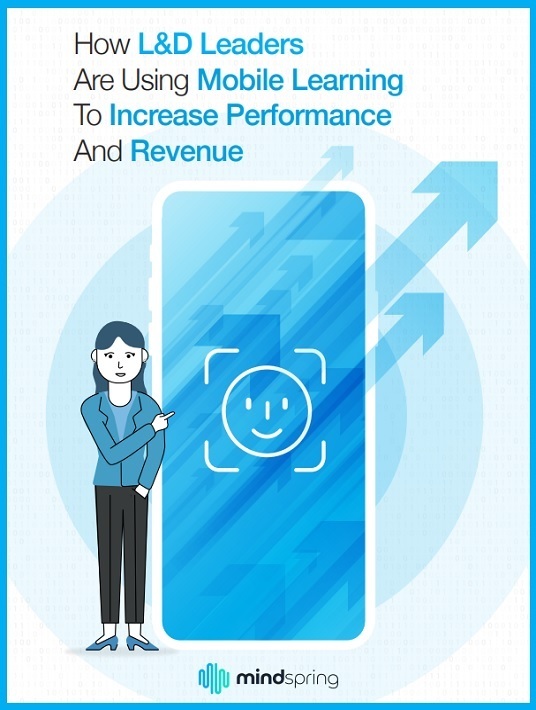What Are The Limits Of Mobile Learning?
What you are about to read is a fable. The company, AshCom, is fictional, but the mobile learning challenges faced by Kathryn, AshCom’s CLO, and her team are real and commonly shared by learning teams in corporations, non-profits, associations, and education. It is our hope that you will be able to connect with the characters, their challenges, and the solutions they discover. We also invite you to read the first eBook in the series.

The Friday Morning Meet-Up
Kathryn flipped on the lights to the large conference room. As she checked for markers at the whiteboard, she heard chair legs scraping against the floor as they slid in and out around the oval conference table behind her. Cheerful voices mixed with the clinking of laptops and coffee mugs on the tabletop as people settled into their spots. Kathryn glanced up at the wall clock. It was exactly 10 a.m. on Friday morning, and the team was assembled. It was time to begin.
Two days earlier, she had asked them to spend 45 minutes thinking together about all the positives of delivering learning experiences through mobile devices. But today’s meeting was what her team called “the negative meeting.” It was a strategy Kathryn occasionally used for big subjects. Rather than some team members focusing on the negative and some on the positive in the same meeting, Kathryn set two shorter meetings. Everyone positive in the first. Everyone negative in the second. No one defensive. She didn’t do this often but only for substantial ideas, like how to create mobile learning for the sales team.
Major Changes After The Merger
Much had changed in the learning team at AshCom since they acquired Globex. The team had grown from five to eight people. They were not only more productive, but they were also learning how to work together. Kathryn knew that some time would be required for them to gel, and she could see that was happening now that they had been together for six months.
The challenge was significant. Ronda, the new Vice-President of Sales, came to Kathryn with a problem. An engineer and an experienced sales leader for one of the largest medical device manufacturers in the world before joining AshCom eight months earlier, Ronda was under a lot of pressure to perform. She led a combined sales force of 286 people in various territories around the United States and Canada.
As if bringing together the salespeople from AshCom and Globex was not enough of a challenge, Ronda also wanted to introduce a new sales system that would be unfamiliar to both groups. All without losing any of the $3.6 billion in sales of the previous year and with the stretch goal of increasing it by four percent.
A new system meant new learning opportunities. The salespeople needed information at their fingertips, and so Ronda asked Kathryn if her team could consider building the entire sales learning system in a way that would be far more mobile friendly.
Negative Day: The Limitations Of Mobile Learning
In the Friday meeting, Kathryn, as was her way, started on time. She usually got straight to the matter at hand without a lot of what she called “happy talk” at the beginning. “This morning,” she said, “is Michael’s favorite day. Today is negative day.”
The team laughed. Michael was a retired college professor who spent time in administration building curriculum. He was a trusted advisor to Kathryn who mostly helped her think about strategy. But he truly had an academic mind and often used the expression “On the one hand…,” followed shortly by “On the other hand….” Michael liked to think through both sides of an argument, and so Kathryn’s technique fit right into how his mind worked.
Instead of using sticky notes as they had done on Wednesday in the “positive” meeting, Kathryn stood at the conference room whiteboard and asked them to list the negatives of mobile learning.
She had given them a heads up that this was coming, and so they were prepared.
The Team Speaks Up
Michael was the first to speak. “I did a little reading and found the topic fascinating. When I was in the university several years ago, we looked at mobile delivery but decided against it. At the time, not enough students had smart phones, and we worried that some would be left out. But I read that percentage has increased in the last few years. It could still be a limiting factor, but I suspect it is a much smaller problem than it used to be. Maybe a survey is in order? One fascinating fact: People with smart phones look at their phone an average of 200 times per day, so maybe part of this falls into the positive category?”
“Ok,” said Kathryn. “Not entirely a negative but worthy of the list.”
Maggie, who had been at AshCom for 20 years, spoke next. “I have a little concern over connectivity. The sales team is spread out all over the US and Canada. Do all 286 account executives have solid internet service even if they have a smartphone?”
“Duly noted,” said Kathryn as she wrote on the whiteboard.
Amy said quickly, “What about hearing?”
The others glanced her way, not entirely clear about what she meant.
Amy continued, “I do worry about whether or not people will be able to hear the voiceover if they are looking at their phones to see what’s on the screen.”
“I hadn’t thought of that one,” said Kathryn as she wrote. “That’s certainly something we need to consider.”
“I need to piggyback on that,” said Alishia. “Will learners be able to see what we need them to see on the screen? What are the limitations of that?” Up on the list it went.
Distractions And Risks
Adeena spoke next. “I’ve done a little reading, and I have two concerns. I’m not sure if they are negatives or not, but I think they belong on the list. The first is should we be worried about other distractions while people are learning on their phones? I was thinking of pop ups or texts that appear in the middle of a learning experience. Or what if they get a phone call? What does that do to their retention?”
“And the second?” said Kathryn, writing “Distractions” on the whiteboard.
“The second one is something I read, and I really don’t know how to answer it because I am not an IT person, but I wonder whether we will have any privacy or security issues with mobile learning?”
Kathryn wrote “Security/Privacy” on the whiteboard and wrote “Check with AshCom IT” after as more of a note to herself.
Kathryn noticed that the newer members of the team had not yet spoken. She paid careful attention to such things.
“Martina and Darryl,” said Kathryn, “you’ve been quiet. Your ID skills are impressive and both of you are highly artistic - an incredible combination for which we are thankful. What is on your minds?”
The two looked at each other wondering who would speak first. Martina decided to dive in. “Darryl and I spent our lunch hour yesterday talking about this. I guess I would first say that what both of us are thinking isn’t necessary a negative. It is more of a limitation. And it isn’t just in mobile.”
Intrigued, everyone turned to face them.
Daryl Takes Over The Whiteboard
“Mind if I use the whiteboard?” asked Darryl. “I think I can show you better than I can tell you.”
“Of course,” said Kathryn.
Darryl and Martina both stood. Martina said, “We did some thinking about the creative process. We both love instructional design, but we also love visual arts. When an instructional designer gets what we would call a ‘big idea,’ we get excited. Not just because it is aesthetically interesting, but because it will create an incredible learning experience for learners.”
On the left side of the whiteboard, Darryl wrote “BIG IDEA” and drew a box around it.
“But,” continued Darryl, “every step forward limits the big idea. The first limitation is the authoring tools we use.” Martina took the marker and wrote “Authoring tool.” She then drew a box around those words, but the box was 25% smaller than the box around “BIG IDEA.”
Darryl continued, “I’m not saying we don’t appreciate the authoring tools we have. They are incredible compared to what was available to us even five years ago. But they are still like the bumpers in bumper bowling. We are immediately limiting what we can do and so the big idea gets smaller.”
Going Through The Motions
“What happens, as you know,” said Martina, “is that the products sort of look the same in the end and the experience is still much the same. Too often, learners are just clicking the ‘next’ button. Practically speaking, the authoring tools allow us to re-size and rotate materials but other than that, unless there is deliberate instructional thought applied, it’s still just an eLearning module but now playing on a mobile device.”
“The next limitation,” said Darryl, “is the learning management system. We know we need it because we need to track the metrics. Without them, we will be blind to whether or not we are meeting our learning objectives. We need to be able to push learning opportunities to learners and give them the ability to pull out the learning they want. But our LMS adds additional limitations to the BIG IDEA that was so exciting when we started.” Martina wrote “LMS” on the whiteboard and, again, reduced the size of the box by 25%.
Michael spoke up. “I don’t want to interrupt your flow of thought, but what does this all have to do with mobile learning specifically?”
The Big Idea
“So glad you asked,” said Martina. “Our concern is that taking a great learning idea through the limitations of our author tools and then the LMS will mean even more limitations if the final delivery is through mobile devices. Learners still must navigate to a website and login, then browse to find the course they want to participate in. So, navigation is difficult and a barrier to use. Imagine being on the subway on the way to work, squinting to find the login block on your phone to even access the materials.” With that, Darryl wrote “Mobile.” The box he drew this time was one quarter the size of the box around the “BIG IDEA.”
“Our concern is this,” continued Martina. “With all the limitations built into our system and our tools, will we lose the instructional strength and creativity? If we want to stay aligned to Kathryn’s concept of designing learning experiences, will it be a further limitation on our design of the learning experiences?”
There was a modicum of tension in the room. The others were aware of the limitations in their tools, but the boxes made those limitations visual. Adding to the tension was that no one appeared to have a solution to this, which was obvious because no one challenged their thinking or what was on the whiteboard. Several seconds passed in silence.
Solid Learning Science, Creative Design, And Tech-Savvy Delivery
Kathryn spoke first. “For a great learning experience, we need solid learning science, powerful creative design, and technically savvy delivery. What I hear you saying is that without all three, mobile might be a challenge because it adds additional limitations. We have to figure out how to keep our Big Ideas intact. This whole thing belongs on the ‘Negative List.’ None of these are truly negative, but they are certainly problems to be solved.”
With this, Amy spoke up. While she was a consultant to Kathryn and AshCom, she also had served in this capacity to dozens of companies and large non-profits around the country. “I want to remind us of something Kathryn talked about at our last meeting. Ronda is our VP of Sales. Her challenge is to bring together the sales teams of AshCom and Globex while also introducing her new sales system and getting them to embrace it.”
“I can tell you,” Amy continued, “that there may be no more important learning opportunities for most companies than sales learning. I believe Kathryn used the expression ‘sales is the lifeblood’ and that is how companies think about their sales team. I can’t predict what the response of owners of AshCom will be, but my guess would be they will support whatever we and Ronda think will be best. But we will need to address each challenge we’ve listed and have answers for how we will get past them.”
Kathryn tapped her watch and said, “Time. I have other meetings this morning, and I’m sure we all have other things to get to. I think we’ve identified some important issues this morning, and we need to find viable solutions, which I’m confident we will. Please spend more time thinking about both the pros and cons of mobile, and I’ll get us all back together in a few days and see where we are.”
With that, everyone stood up and left the conference room. Kathryn remained for several minutes, alone, looking at the whiteboard and jotting notes in her notebook.
Conclusion
To read the rest of the chapters in this series on Mobile Learning and to see Kathryn and her team solve their challenges, please download the eBook How L&D Leaders Are Using Mobile Learning To Increase Performance And Revenue. It can help you determine if custom mobile learning is the right approach for your organization and uncover tried-and-tested methods. Also, join the webinar to learn how custom mobile learning apps can empower sales teams.










